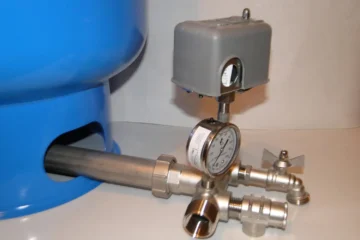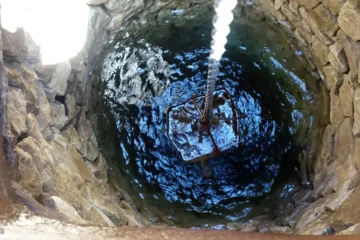Having your well is a great way to make sure your home always has safe water, no matter the season. Wells are usually dug outside your house, going deep into the ground to get water from underground rivers or aquifers.
Even though wells give you a steady water source, they can get dirty from stuff in the ground, which might change the water’s color. If your well water looks yellow, things like iron bacteria or natural materials could be causing it, which might not be good for your health.
In this article, we’ll discuss the dangerous effect of yellow well water on our bodies and the solutions.
Is Yellow Well Water Dangerous?
Yellow water that comes from underground sources that contain iron bacteria is not safe to drink. But, it’s still a good idea to avoid drinking it until you can test it properly. Contaminants in your well water could cause different health problems, like stomach issues or even serious illnesses.
So, it’s better to be careful and not take any risks. Doctors always advise drinking clean and properly filtered well water because water causes many health problems.
Why Is My Well Water Yellow?
If you see sudden yellow water in your well, it’s likely because of things like iron bacteria, rusty pipes, or dirt in the well. While these might not immediately make you sick, they signal that your well could be polluted. Drinking polluted water can harm your health in the long term, so it’s important to act fast.
First, test the water to find out what’s causing the yellow color, even if it’s from rainwater or melted snow. Rainwater can carry harmful stuff that can make you sick now or later.
Let’s look closer at the main reasons for yellow water:
1. Ferric Iron Contamination
Ferric iron happens when dissolved iron in water reacts with oxygen, turning it into a solid. This can give your water a yellow or brown color and a metallic taste. While it’s not immediately harmful, it can stain things and clog appliances.
To get rid of ferric iron from well water, the best way is to use a special filter made for removing iron. One popular choice is the 6 Best Water Softener for Well Water with Iron Removal. They are known for doing a good job of removing iron, sulfur, and manganese from well water.
2. Rusty Pipes
Old well pipes are usually made of iron, which can rust over time if not taken care of. When water flows through these pipes, it picks up tiny bits of iron and rust, making the water turn yellow.
The best way to fix rusty pipes is to replace them with new ones, even though it might cost a bit. While this might mean spending money, it’s the best way to solve the problem. It’s important to hire a certified professional to do the replacement to make sure it’s done right.
3. Iron Bacteria
Iron bacteria are tiny organisms that live in water and soil. They get their energy by oxidizing iron, manganese, and other metals. This process can cause staining, clogging, and water to change color.
Yellow water isn’t the only sign of iron bacteria. They can also make well water look orange, red, brown, or yellow. You might also notice a swampy or oily taste, which shows that iron bacteria are in your well.
4. Organic Material
Tannin filters are often used to remove tannins from well water. These filters work by absorbing tannins into a special filter material, which can then be removed from the system. Springwell Tannins System, which not only deals with the organic material that causes yellow well water but also makes the water soft.
Apart from using tannin filters, you can also get rid of tannins in well water by using methods like oxidation, activated carbon filters, and reverse osmosis (RO). But it’s best to talk to a water treatment expert to figure out the best solution for your situation.
How To Treat Yellow Well Water?
Different treatments are available depending on what’s causing the problem.
But they all have one thing in common: regular testing.
Step 1: Test Your Well Water
Getting your testing well water helps to figure out what’s causing the problem and what to do about it. It’s best to test your well every spring, especially after the snow melts, to check for bacteria, dissolved solids, other possible contaminants, and pH levels.
But sometimes you might need to test it sooner, like after a natural disaster or if your water suddenly smells weird. Seeing a yellow color in the water is also a sign that something’s not right.
Step 2: Treatment
After figuring out what’s causing the problem, you can pick the best treatment. This might mean replacing pipes or installing an iron filter system.
1. Use an Iron Filter System
If ferric iron is making your water yellow, the best fix is to use a water filter to remove iron. One popular choice is the Spring Well Whole House Iron Filter.
2. Replace Your Rusted Pipes
If rusty pipes are causing your yellow water, the only way to fix it is to replace the pipes completely. Make sure to hire a qualified professional to replace your well water pipes properly.
3. Tannin Filters
If your water tests show there are tannins, using tannin filters is the best way to get rid of them. The Spring Well Tannins System is known as one of the top tannin filters.
Sometimes, if the tannin levels are high, you might need more advanced filters like RO systems to remove them.
If that’s the case, it’s best to get advice from a professional.
4. Removal of Iron Bacteria
Getting rid of iron bacteria can be tough for DIY enthusiasts. It involves using disinfectants, surfactants, acids, chlorine, and pasteurization.
Luckily, many states in America, like Minnesota, have programs for treating wells and offer help from professionals.
So, before you try to remove iron bacteria yourself, it’s a good idea to contact the authorities in your state.
5. Reverse Osmosis System
Reverse osmosis is a method that gets rid of contaminants from water by pushing them through a special membrane. It’s good at removing lots of different pollutants, tannins, iron, and bacteria.
Luckily, we have an article that talks about the best RO systems for dealing with yellow well water. Make sure to check it out!
5. UV Disinfection Treatment
UV disinfection uses ultraviolet light to kill bacteria and other tiny organisms, which makes it a good way to get rid of iron bacteria from water.
But it’s important to have a qualified professional do UV disinfection or use it as part of a bigger filtration system for well water.
Step 3: Re-test Your Well Water
After choosing and applying treatment, it’s important to do another test. This will make sure that the treatment works and that your well water is safe to drink.
If chlorine was used in the treatment, it’s also important to check the water for chlorine levels.
Conclusion
Ensuring safe and clean well water is crucial for maintaining good health in our homes. While having a well provides a steady water source, it’s essential to be aware of potential contaminants that can lead to yellow discoloration and health risks.
Whether it’s ferric iron contamination, rusty pipes, iron bacteria, or organic material, identifying the cause of yellow water is the first step towards finding the appropriate treatment.
Regular testing of well water is paramount to detect any issues promptly. Treatment options range from using iron filters, replacing pipes, employing tannin filters, and addressing iron bacteria, to utilizing reverse osmosis systems or UV disinfection treatments. By taking proactive measures and maintaining vigilance, homeowners can ensure their well water remains clean, safe, and free from yellow discoloration.
FAQs
What causes well water to turn yellow?
Yellow well water is often caused by elevated levels of iron in the water. When iron oxidizes, it can give the water a yellow or reddish tint.
How can yellow well water affect plumbing and appliances?
Yellow well water can stain plumbing fixtures and laundry, and it can also cause build-up in pipes and appliances like water heaters and washing machines.
Can yellow well water affect the taste of food and beverages prepared with it?
Yes, yellow well water can impart a metallic taste to food and beverages, which may be undesirable to some people.
What steps can be taken to treat yellow well water?
Treatment options for yellow well water include filtration systems, water softeners, and chemical treatments to remove or neutralize the iron and other contaminants.
Can yellow well water be harmful to household plants and gardens?
High iron levels in yellow well water can harm certain plants and affect soil pH levels. It’s recommended to have the water tested and, if necessary, treat it before using it for irrigation purposes.





